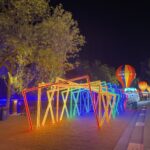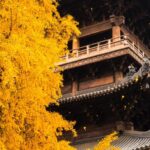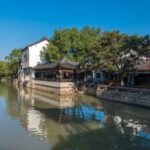The Master-of-Nets Garden is a typical Suzhou garden. With an area less than one-sixth of that of the Humble Administrator’s Garden, through ingenious layout, the small bridges, flowing water, pavilions and towers do not appear cramped. It is a model of ‘seeing the big from the small’. In addition to understanding the mystery of the layout, when the night garden is open every year, enjoying folk art performances at night is another major feature here.
The Master-of-Nets Garden was originally built during the Chunxi period of the Southern Song Dynasty (1174 – 1189 AD). It was originally the site of ‘Wanjuan Hall’. The garden was named ‘Fisherman’s Retreat’, which, like the current name, also means retiring from the world. Most of the scenery of the Master-of-Nets Garden that we see now are relics after restoration and expansion in the late years of the Qianlong period of the Qing Dynasty. In the center of the garden is a large pond – Cai Xia Chi. All buildings surround the pond. The eastern part is the residential area, the northern part is the study area, the western part is the inner garden area, and the southern part is the banquet and entertainment area. The garden has two gates, the north gate and the southeast gate. The north gate is the back gate, and the southeast gate is the main gate. It is recommended to enter from the southeast gate and tour counterclockwise around the pond to see all the buildings in the garden. In the eastern area of the garden, from south to north are the sedan hall, the main hall Wanjuan Hall, the Xieu Building used for the owner’s living and receiving guests, the Wufeng Book House used for storing books (the former site of the Southern Song Dynasty’s ‘Wanjuan Hall’). To the northeast of the Wufeng Book House is the Tiyun Room. There is a sedan chair in the sedan hall with extremely detailed carvings almost to the point of being hollowed out. The gate towers opposite Wanjuan Hall and in front of Xieu Building both have exquisite brick carvings. The doors and windows of the Tiyun Room have beautiful wood carvings. Pay attention to these points when touring. From the Wufeng Book House, along the north side of Cai Xia Chi, walk west to tour the northern area of the garden. To the west of the Wufeng Book House are the Jixu Studio used by the owner for reading, and the Zhuwai Yizhi Xuan used by the children of the garden owner for reading. Walking further west to the Kansong Duhua Xuan is a place to appreciate the scenery in the garden. There are pine and cypress trees planted in front of it. Admiring flowers in spring, listening to cicadas in summer, smelling the fragrance of osmanthus in autumn, and watching snow cover the pine and cypress in winter. The scenery of all four seasons is like a series of paintings. The two words ‘reading paintings’ are very appropriate. Then continue west to a relatively independent area – the inner garden area in the west. The painter Zhang Daqian once lived in the Dianchun Yi in the inner garden. In order to paint tigers well, he also raised tigers in the courtyard. Later, the tiger died. Now, under the semi-pavilion on the westernmost wall of the Master-of-Nets Garden, you can still see the tombstone erected by Zhang Daqian for the tiger. Walking south, you arrive at the Moon Arriving and Wind Coming Pavilion located in the middle of the western part of the garden. The pavilion is next to Cai Xia Chi and you can see the buildings with white walls and black tiles around the pond quietly reflected in the water. At night, it is also a good place to enjoy the moon. There is also a large mirror in the pavilion, which plays a role in visually expanding the space. Continuing south and passing through the Zhuoying Water Pavilion, you come to the southern area of the garden. Here there is a music room where the owner plays the zither and the Daohe Hall used for leisure living.Ascending the artificial mountain made of yellow stones to the east, one can overlook the garden’s scenery from the Yungang peak. Continuing eastward, you will pass by the Small Hill Hall of Cassia, where the owner lived and received guests, and you will notice an incredibly mini bridge lying over a small stream, named the ‘Jingyin Bridge’. This small bridge is a famous architectural feature of Wangshi Garden, with five steps on each side and can be crossed in just three steps. The bridge is located at the confluence of the stream and the Caixia Pond, and its small size contrasts to make the Caixia Pond appear more spacious, and the garden’s space seems to expand.

To the north of Wangshi Garden is the famous Suzhou dining and crafts street, Shiquan Street. Not only Shiquan Street, but also the intersecting Fenghuang Street, are lined with many restaurants. Old Suzhou Tea and Wine Building and Xiehe Restaurant both serve authentic Suzhou dishes, where you can taste local specialties such as squirrel-shaped mandarin fish, oily eel paste, and green snail shrimp. Craft products include Suzhou embroidery, calligraphy, and silk. Nearby accommodations include Nanlin Hotel, Suzhou Residence Hotel, and Nanyuan Hotel. There is also the scenic spot Canglang Pavilion in the vicinity, which can be visited together.

Wangshi Night Garden is a classic Suzhou tourism product and a well-known tourism brand at home and abroad, recommended by UNESCO as a specific tourism project. As a long-standing Suzhou night tour product, after thirty years of interpretation and precipitation, in March 2021, Wangshi Night Garden returned with a brand-new experience upgrade! The new night tour of Wangshi Garden has increased participation and experience.

Open from 03/01 to 10/31 from 07:30 to 17:30; from 11/01 to 02/28 from 07:30 to 17:00.
Medical staff in Suzhou city, when visiting the scenic area, please present your ‘Personal ID’ along with the ‘Free Garden Admission Card for Suzhou Medical Staff (Electronic Card)’, and you will be able to enter the garden without an appointment, exempt from the first admission fee.
Free service facilities: WIFI – Account: Wangshi Garden; Password: No password required; Coverage: Scenic area visitor service center. Luggage storage: Reference price: Free. Scenic area interpretation: Manual interpretation services are provided at the entrance of the scenic area, in the sedan chair hall. Cost: Free. Guided tours (free interpretation times: 8:20/9:00/9:40/10:20/11:00/12:30/13:10/13:50/14:30/15:10/15:50); Paid guided tours (1-5 people, 60 yuan; 6-10 people, 80 yuan; 11-20 people, 100 yuan; more than 20 people, 140 yuan). Restrooms: Multiple restrooms are located within the Wangshi Garden scenic area, near Yun Kong and Lu Hua Hall, with clear signs indicating their locations.








